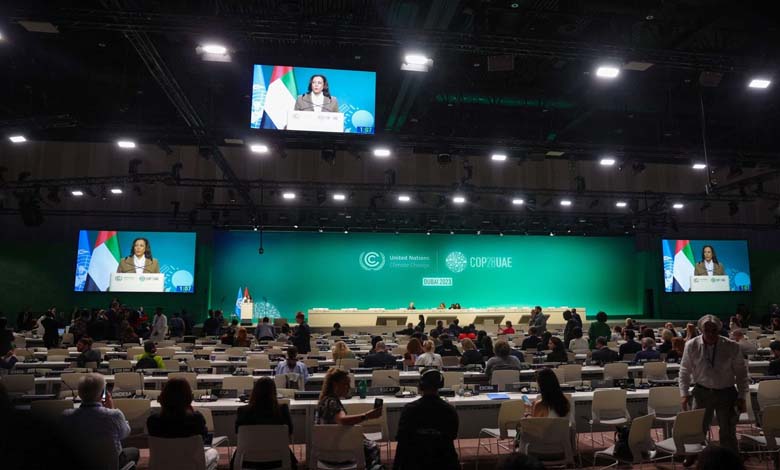Unprecedented interest in renewable and nuclear energy at the climate conference in Dubai
Leaders of participating countries in COP 28 confirm that nuclear energy is the future alternative to fossil fuels

Energy sources took center stage on Saturday at the United Nations Climate Conference in Dubai, with a focus on nuclear and solar energy, ahead of challenging negotiations among nearly 200 countries on fossil fuels in the next ten days after the focus shifted to financing on Friday.
The third day of the conference, which runs until December 12, began with more than 20 countries calling for a threefold increase in global nuclear energy sources by 2050 compared to 2020, indicating a renewed interest in atomic energy that allows for almost carbon-free electricity generation, but also recalling the Fukushima disaster in Japan in 2011.
US Special Envoy for Climate John Kerry said during an event held at the conference alongside several leaders, notably Europeans, “We understand from science and the facts and evidence that we cannot achieve carbon neutrality by 2050 without nuclear energy.”
-
Inspirational youth projects.. How UAE’s youth are preparing for COP 28 on climate change in the UAE
French President Emmanuel Macron said, “I want to reaffirm that nuclear energy is clean energy; we should repeat that.” His Polish counterpart, Andrzej Duda, affirmed that “nuclear energy is the future.”
In addition to the United States and Canada, the list of signatories included about twenty countries, including the United Arab Emirates and European countries, supportive of nuclear energy, as well as South Korea, Ghana, and Japan. The UAE recently announced the construction of its first nuclear power plant, while Japan stated that it would restart its nuclear stations.
However, the list excluded China and Russia, two prominent countries in the nuclear power plant construction sector globally.
The text represents a non-binding voluntary call aiming to proactively promote alternative energies to fossil fuels and to hold a position in climate negotiations, seeking to end reliance on oil, coal, and gas in the final agreement of the conference.
Environmental advocates prefer a transition to a nuclear-free world, highlighting the issue of nuclear waste and safety. Following the call, Masayoshi Iida of the “350.org” environmental organization condemned the use of what he described as “dangerous” energy. He said, “We have less expensive and safer solutions that are also democratic and quickly respond to the climate crisis, and those are renewable energy and energy efficiency.”
Another call is expected to be made by countries with a consensus position on Saturday in Dubai to double renewable energy capacities (solar, wind, hydropower, biomass, etc.) three times by 2030. More than 110 countries are expected to sign this call.
-
International climate action… How is the UAE enhancing its role in this regard as COP 28 approaches?
The European Union had already launched a similar call in the spring, supported by the UAE presidency of COP28, and it was later adopted by the G7 and G20, responsible for 80% of global greenhouse gas emissions.
European Commission President Ursula von der Leyen said on Friday in Dubai, “Today, our call has turned into a powerful movement, and more than 110 countries have already joined it… I invite you all to include these goals in the final decision of the COP, and then we will send a strong message to investors and consumers.”
116 countries signed a non-binding commitment on Saturday aiming to triple global renewable energy capacities by 2030, as announced by the presidency of the climate conference. These countries pledged to “work together” to increase global capacities for solar, wind, and hydropower to 11,000 gigawatts by the end of the decade, taking into account “differences and national conditions” for various countries. The current capacities for renewable energy worldwide are 3,400 gigawatts.
Additionally, the countries committed to doubling the annual pace of progress in energy efficiency by 2030, from 2% to 4%.
U.S. Vice President Kamala Harris announced on Saturday during the United Nations Climate Conference (COP28) in Dubai a contribution of three billion dollars to the “Green Climate Fund.” This comes after the wealthiest country in the world had ceased contributions for several years. Harris, representing the U.S. President at the conference, stated, “I am proud to announce a new commitment of three billion dollars to the Green Climate Fund.” The last time the U.S. contributed to this fund was in 2014, during the presidency of Barack Obama, with a value of three billion dollars. Many other countries renewed their contributions at this time.
While conditional on the approval of the U.S. Congress, this announcement was a long-awaited positive signal, hoping to ease tensions between northern and southern countries regarding global climate finance—a contentious issue in United Nations climate negotiations. If the promise is fulfilled, the United States will become the largest contributor to the fund in absolute terms, with a total of six billion dollars. However, the contributions of the United Kingdom (5.1 billion dollars, according to the non-governmental organization Oxfam) and Germany (4.9 billion dollars), and France (4.6 billion dollars) are much larger in proportion to their populations. The Green Climate Fund, established in 2010, is currently the largest operational fund.
The fund supports solar panels in Pakistan, as well as agricultural projects in the Philippines and other initiatives aimed at helping developing countries abandon fossil fuels or adapt to a more dangerous climate. According to the fund’s management, over four billion dollars have been disbursed so far, with a commitment to contribute 13.5 billion dollars. However, its ambitions are greater: it aims to increase its current capital of 17 billion dollars to 50 billion by 2030.
After efforts lasting more than two years, the United States announced on Saturday its final standards aimed at reducing methane emissions from the oil and gas sector, a crucial step to fulfill its commitments regarding this harmful gas. The announcement was made by the U.S. Environmental Protection Agency during the conference. The issue of methane, the largest contributor to climate change after carbon dioxide, occupies a significant place at this year’s conference. China, the United States, and the UAE organized a joint summit on methane and other greenhouse gases alongside carbon dioxide.
The United States had previously proposed standards in this regard in 2021 and 2022. Then, the U.S. Environmental Protection Agency received “over a million” public comments, stating that it consulted with a large number of stakeholders. The final standards announced on Saturday will reduce methane emissions by 58 million tons between 2024 and 2038, according to the agency. This quantity is equivalent to 1.5 billion tons of carbon dioxide, roughly matching the carbon dioxide emissions from the U.S. energy sector in 2021. Different U.S. states were given two years to submit their plans to the Environmental Protection Agency to reduce these emissions. Overall, methane emissions from the expected sector for 2038 will be reduced by 80% without taking any action, thanks to the new standards, according to estimates from the U.S. Environmental Protection Agency.












